Posts Tagged ‘Baseball in WWII’


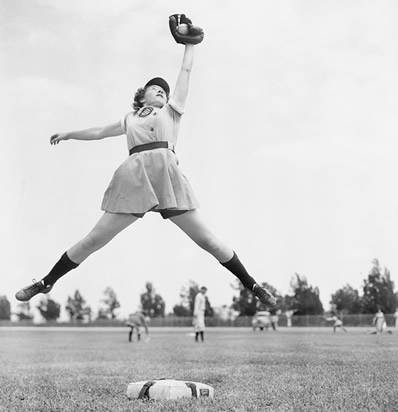
Dorothy Harrell, star shortstop for the Chicago Colleens (Photo Credit: Bettmann/CORBIS)
On May 30, 1943, the All-American Girls Professional Baseball League (AAGPBL) made its debut, with the South Bend Blue Sox (Indiana) beating the Rockford Peaches (Illinois), 1-0 and the Kenosha Shamrocks (Wisconsin) beating the Racine Belles (Wisconsin), 8-6.
Women in Baseball
Women have been playing professional baseball since the 1940s, yet it wasn’t really a well know fact until the 1992 Penny Marshall movie, A League of Their Own, starring Tom Hanks, that put these women in the public eye.
In 1943, The United States was in full force fighting in World War II. P.K. Wrigley received word from President Franklin Delano Roosevelt that the 1943 Major League baseball season might be suspended due to manpower shortage. He wanted Wrigley to do something to keep the baseball game going until the men got home from service.
In the midst of removing barriers for women to be able to work in the industry to help the war effort, Wrigley joined forces with Branch Rickey and several small town entrepreneurs to create the first professional baseball league for women. A new game was born. Using rules from the men’s game the game became a faster action game than softball. In 1943, when the league began, the girls were actually playing fast-pitch softball using an underhand pitching delivery, but with certain variations to make the game faster. Runners were allowed to lead off and steal, and the size of the diamond was larger than the field used in softball but smaller than a baseball diamond.
The women of the league were expected to act like ladies and had to abide to the rules of conduct and had to attend charm school to continue to act as a proper lady. Wrigley and his advertising agent promoted the new “Girls Baseball” as wholesome family entertainment for war workers.
Thirty scouts were hired to start looking for outstanding softball players all over the United States and Canada. Four teams were formed and the league started its first season in 1943. In 1944, the All American Girls Professional Baseball League expanded to six teams. By 1946 eight teams were playing 110 games per season.
The schedule of 110-120 games per season consisted of playing single games six days a week plus double headers on Sundays. The only time off were rained out games and then they were made up by doubleheaders next time around. Traveling was done by bus between the different cities leaving right after the game and sometimes arriving just in time to play the next game in the new city.
The pay schedule was from $55.00 to $125.00 per week. In the 1940s and early 1950s that was not bad pay for playing a game that was fun. Expenses on the road were paid by the team including $2.25 per day for meals.
The league lasted from 1943 – 1954. In 1948, the league drew a record 910,000 fans for the 10 team league. The All American Girls Professional Baseball League memorabilia was enshrined in the Cooperstown, New York Hall of Fame on November 5, 1988. Over 550 names are on a plaque in the exhibit named Women in Baseball.
Posted by Lauren Handley, Education Program Coordinator.
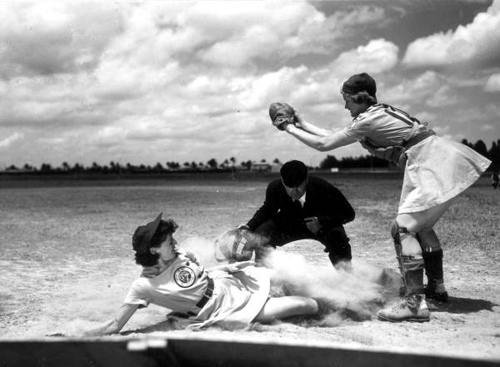
All American Girls Professional Baseball League player Marg Callaghan sliding into home plate - April 22, 1948



St Louis and all baseball fans everywhere lost a legend this past week. Stan “The Man” Musial died at age 92 in the St Louis area surrounded by family. As a lifelong Cardinals fan who grew up in the St Louis area, I know the heavy hearts my hometown feels. We saw him every opening day. We saw him around town, always with a harmonica in his pocket at the ready. Upon returning from a trip one summer while I was in high school, Stan just happened to be waiting for luggage from his own trip in the baggage claim at the airport. People quickly realized who he was and a crowd gathered. Someone asked him to play, and he obliged. I listened to his rendition of “Take Me Out to the Ballgame” while watching the carousel. So many people have so many stories about Stan, who spent his entire career in St Louis save the 1945 season, when he was based in Pearl Harbor with the Navy during World War II.
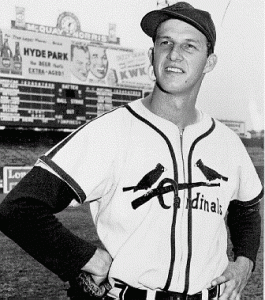
Stan Musial started out as a pitcher in the minors. The Cardinals signed him when he was still in high school in 1937. He had injury issues with his left arm, limiting his pitching, but his hitting ability had him in the outfield between starts. He joined the Cardinals during a playoff run in 1941, just months before Pearl Harbor. He helped the Cardinals to World Series titles in 1942 and 1944. Because he was married and had a child, he was initially not eligible for military service, but during the winter months of 1943-1944, fresh from winning the 1943 MVP award, he participated in a USO tour entertaining the troops in Alaska and the Aleutians.
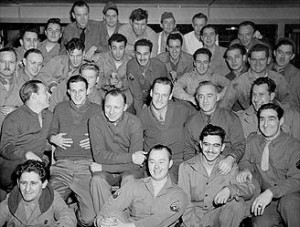
Musial is in the second row, second from the left
As war progressed and eligibility requirements changed, Musial picked the Navy to enter into his country’s service during World War II. His induction was delayed to play out the 1944 season. Musial had passed his Naval physical examination in June 1944 and reported for induction on January 23, 1945. He was assigned to Bainbridge Naval Training Center in Maryland and played for the Bainbridge NTC Commodores baseball team. Musial credits his time at Bainbridge with helping him develop as a power hitter, stating that he altered his stance to pull the ball so he could hit more homeruns to entertain the servicemen.
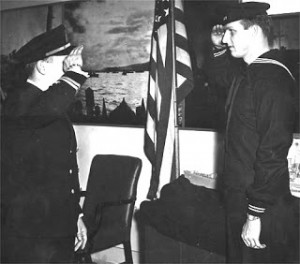
He was then assigned to a ship repair unit in Pearl Harbor, Hawaii. There he would play baseball three to four afternoons per week for the Ship Repair Unit Team in the 14th Naval District League. He batted .380. “Ten thousand every game,” Musial recalled. “You know, there were so many men around Hawaii, goddamn thousands and thousands of guys, so this was good diversion for them.” In August 1945, he even resurrected his pitching career, blanking an Army all-star team with a four-hitter in a game at Maui.
On March 15, 1946, he was honorably discharged from the Navy and promptly returned to the Cardinals to enjoy an MVP season batting .365 with 103 RBIs.
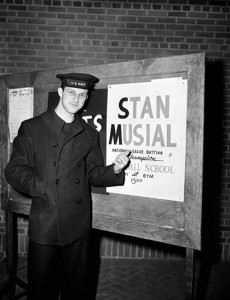
Stan “The Man” Musial continued to delight fans for the rest of his career, never striking out 50 times in one season. He held 55 records when he retired in 1963. He was a St Louis Cardinal for life with 24 All-Star appearances and the adoration of generations of St Louis Cardinals fans. Opening Day won’t be the same this year.
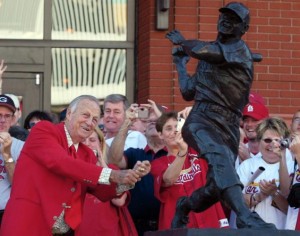
**I pulled his career and military information from several websites, however, the most helpful was certainly Baseball in Wartime. Please visit for more detailed information on Stan Musial’s World War II service.
Posted by Lauren Handley, Education Programs Coordinator











